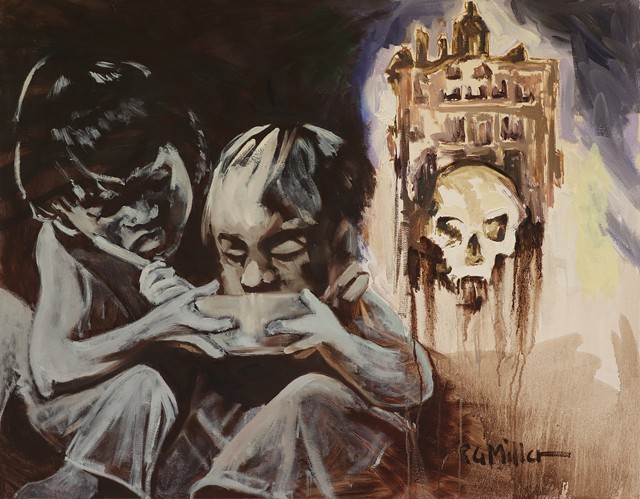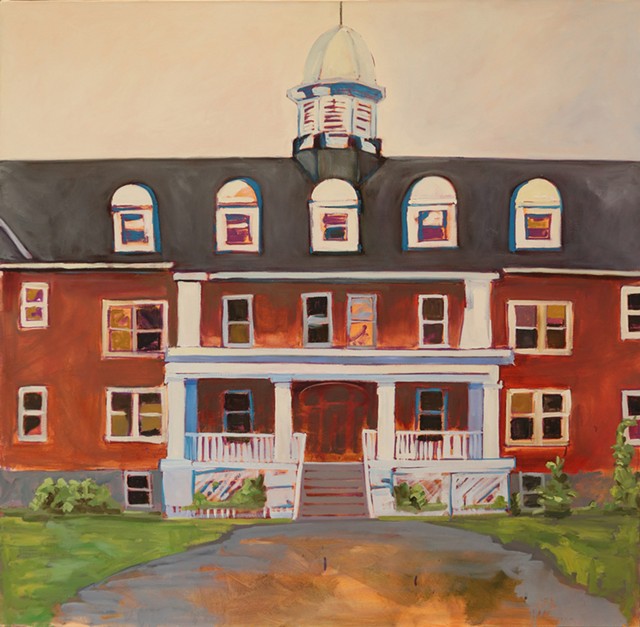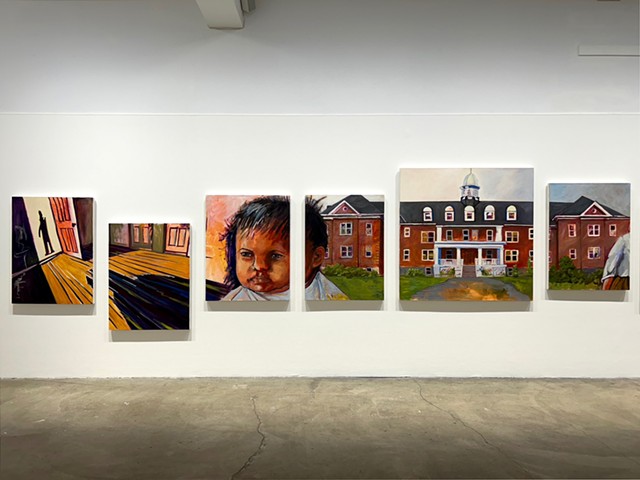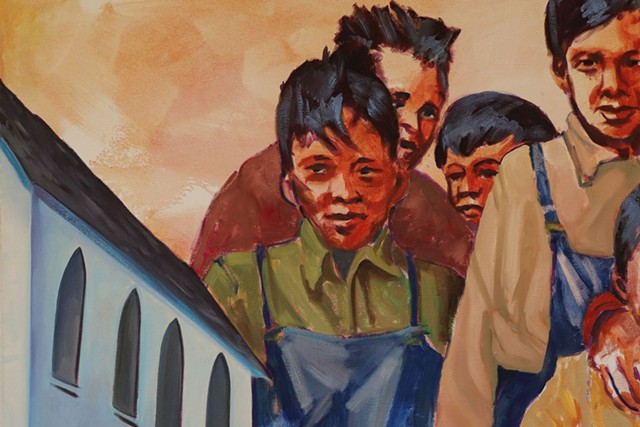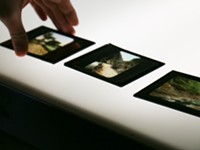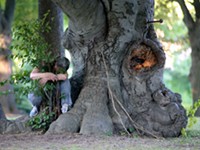[
{
"name": "500x250 Ad",
"insertPoint": "5",
"component": "15667920",
"parentWrapperClass": "",
"requiredCountToDisplay": "1"
}
]
Before Robert Gary Miller learned to paint, he learned to survive.
At age three, Miller was forcibly removed from his home and taken to the Mohawk Institute Residential School in Ontario, Canada, where he spent the next 11 years enduring physical and emotional violence and other abuse. “It's not a popular subject, but it is a story that eventually has to be told,” Miller said.
Years later, he told it himself through visual artwork.
“R.G. Miller: Tsi Non:we Entewaha’hara’ne / Our Path Forward,” which opens at the Rochester Contemporary Art Center on Aug. 30, features works by Miller that reflect his experiences at the “Mush Hole,” as Miller and many others called it, between 1953 and 1964. Residential schools sought to “kill the Indian in the child,” as government officials proclaimed, through forced assimilation.
“The Mush Hole is a death house,” Miller wrote to accompany the pieces. “It’s physical death. It’s spiritual death. It’s the death of your culture. The death of your language.”
The exhibition features large oil paintings — including the 40-foot long multi-panel “Mush Hole Wampum Belt” — as well as collages and mixed-media sketches. One harrowing work titled “Postcard” pairs two hungry children with the building’s facade in thick paint streaks, juxtaposed with a skull.
Curator Neal Keating has worked with Miller on the exhibition since 2007. The pieces date back even further to 2003.
Keating first met Miller in 1999 at Miller’s studio in Peterborough, Ontario.
“We started talking about his art, and within about five minutes, we started talking about residential schools,” Keating said. “I asked Gary, ‘Have you ever made any art about residential schools?’”
Miller hadn’t. He trained at the Ontario College of Art after his time at the Mush Hole. As such, he didn’t grow up learning to paint in what he referred to as an Indigenous style.
“My art was basically art for art's sake,” he said. “My art history is that of all of the artists, mainly Impressionists, the Expressionists and the Abstractionists in Europe in particular.”
Miller became a landscape painter, reflecting the beauty of his homeland.
“I just was more interested in my art than I was in trying to tell a story about my experiences at the residential school,” he said.
But in 2003, Miller was offered a residency at Ontario’s Woodland Cultural Centre, the Indigenous preservation organization that occupies the site of the former Mush Hole. After talking it through with Keating, Miller got to work.
“It was hard because I had to take advice from Neil and other people as to just how far to go,” Miller said. “I was very ambivalent about what I painted to try and make sure that I could come as close to what was happening.”
Keating helped curate the first showing in 2008. Since then, he said, it’s been difficult to get the exhibition out to the public.
“It's not because of the quality of the art. Gary is a professionally trained artist and an extremely creative painter,” Keating said. “The issue really has to do with what the exhibit is talking about.”
It arrives in Rochester at a crucial time. In July, the United States Interior Department concluded a three-year investigation into the repressive policies of domestic boarding schools, the American equivalent of Canada’s institutes like the Mush Hole. The report, led by Interior Secretary Deb Haaland, confirmed that nearly 1,000 Indigenous children died while in the system and acknowledged that the number is likely much higher.
In Miller’s native Canada, the progress has been much more defined. The Truth and Reconciliation Commission, founded in 2008, spent years collecting testimonies from nearly 7,000 witnesses and eventually released 94 calls to action to advance reconciliation.
“This exhibit really came into existence before the [Canadian] government apologized to Indigenous peoples for what had happened to them in residential schools,” Keating said. “It was a little ahead of its time.”
RoCo’s executive director, Bleu Cease, celebrated the exhibition for its visually staggering pieces, both in subject matter and physical scale, as well as Miller’s stature as a mature artist.
“That R.G. has this powerful body of work and has a long career make it a likely fit for our mission to support artists conveying both their life story and also other issues that they might be dealing with through their artwork,” he said.
Given that nearly 20 years have passed since Miller’s Mush Hole work was first presented, Keating said there are two distinct audiences for the exhibition: “those who know and those who don’t.” About 1,000 fellow residential-school survivors have seen the work in the last few years.
“It affirms what they've gone through,” Keating said.
Their response is much different than someone learning about the abuse for the first time.
Thanks to the education system established by settler colonialism, Keating said the larger audience may be completely unaware of the history of these institutions.
“We're launching in this exhibit in a slightly new approach, which is to talk not just about the damage and the horrors of the schools, but to also draw attention to the fact of survivors and resilience,” he said.
Part of that process is complementary programming, including a presentation from fellow Indigenous artist Lauren Jimerson called “Resilience / Survivance / Care” on First Friday, Sept. 6. Jimerson said the conversation around trauma and residential schools has opened up in the past decade, concurrent with her own studies of art therapy with a specialization in historical trauma.
“But what isn't part of the conversation is the role of unconditional love and how that's actually a healing force,” Jimerson said.
The very name of the exhibition itself, “Our Path Forward,” evokes both a brighter future and the shared path that can come after reconciliation and healing.
“The exhibit is a prime example of that,” Keating said. “They did not succeed in killing the Indian inside Gary. You can look at the art for yourself and see that.”
“R.G. Miller: Tsi Non:we Entewaha’hara’ne / Our Path Forward” opens at RoCo on Friday, Aug. 30 with an artist and curator talk at 6 p.m. A First Friday reception, including Lauren Jimerson’s “Resilience / Survivance / Care” talk, follows on Friday, Sept. 6. More details here.
Patrick Hosken is an arts writer for CITY. He can be reached at [email protected].
At age three, Miller was forcibly removed from his home and taken to the Mohawk Institute Residential School in Ontario, Canada, where he spent the next 11 years enduring physical and emotional violence and other abuse. “It's not a popular subject, but it is a story that eventually has to be told,” Miller said.
Years later, he told it himself through visual artwork.
“R.G. Miller: Tsi Non:we Entewaha’hara’ne / Our Path Forward,” which opens at the Rochester Contemporary Art Center on Aug. 30, features works by Miller that reflect his experiences at the “Mush Hole,” as Miller and many others called it, between 1953 and 1964. Residential schools sought to “kill the Indian in the child,” as government officials proclaimed, through forced assimilation.
“The Mush Hole is a death house,” Miller wrote to accompany the pieces. “It’s physical death. It’s spiritual death. It’s the death of your culture. The death of your language.”
The exhibition features large oil paintings — including the 40-foot long multi-panel “Mush Hole Wampum Belt” — as well as collages and mixed-media sketches. One harrowing work titled “Postcard” pairs two hungry children with the building’s facade in thick paint streaks, juxtaposed with a skull.
Curator Neal Keating has worked with Miller on the exhibition since 2007. The pieces date back even further to 2003.
Keating first met Miller in 1999 at Miller’s studio in Peterborough, Ontario.
“We started talking about his art, and within about five minutes, we started talking about residential schools,” Keating said. “I asked Gary, ‘Have you ever made any art about residential schools?’”
Miller hadn’t. He trained at the Ontario College of Art after his time at the Mush Hole. As such, he didn’t grow up learning to paint in what he referred to as an Indigenous style.
“My art was basically art for art's sake,” he said. “My art history is that of all of the artists, mainly Impressionists, the Expressionists and the Abstractionists in Europe in particular.”
Miller became a landscape painter, reflecting the beauty of his homeland.
“I just was more interested in my art than I was in trying to tell a story about my experiences at the residential school,” he said.
But in 2003, Miller was offered a residency at Ontario’s Woodland Cultural Centre, the Indigenous preservation organization that occupies the site of the former Mush Hole. After talking it through with Keating, Miller got to work.
“It was hard because I had to take advice from Neil and other people as to just how far to go,” Miller said. “I was very ambivalent about what I painted to try and make sure that I could come as close to what was happening.”
Keating helped curate the first showing in 2008. Since then, he said, it’s been difficult to get the exhibition out to the public.
“It's not because of the quality of the art. Gary is a professionally trained artist and an extremely creative painter,” Keating said. “The issue really has to do with what the exhibit is talking about.”
It arrives in Rochester at a crucial time. In July, the United States Interior Department concluded a three-year investigation into the repressive policies of domestic boarding schools, the American equivalent of Canada’s institutes like the Mush Hole. The report, led by Interior Secretary Deb Haaland, confirmed that nearly 1,000 Indigenous children died while in the system and acknowledged that the number is likely much higher.
In Miller’s native Canada, the progress has been much more defined. The Truth and Reconciliation Commission, founded in 2008, spent years collecting testimonies from nearly 7,000 witnesses and eventually released 94 calls to action to advance reconciliation.
“This exhibit really came into existence before the [Canadian] government apologized to Indigenous peoples for what had happened to them in residential schools,” Keating said. “It was a little ahead of its time.”
RoCo’s executive director, Bleu Cease, celebrated the exhibition for its visually staggering pieces, both in subject matter and physical scale, as well as Miller’s stature as a mature artist.
“That R.G. has this powerful body of work and has a long career make it a likely fit for our mission to support artists conveying both their life story and also other issues that they might be dealing with through their artwork,” he said.
Given that nearly 20 years have passed since Miller’s Mush Hole work was first presented, Keating said there are two distinct audiences for the exhibition: “those who know and those who don’t.” About 1,000 fellow residential-school survivors have seen the work in the last few years.
“It affirms what they've gone through,” Keating said.
Their response is much different than someone learning about the abuse for the first time.
Thanks to the education system established by settler colonialism, Keating said the larger audience may be completely unaware of the history of these institutions.
“We're launching in this exhibit in a slightly new approach, which is to talk not just about the damage and the horrors of the schools, but to also draw attention to the fact of survivors and resilience,” he said.
Part of that process is complementary programming, including a presentation from fellow Indigenous artist Lauren Jimerson called “Resilience / Survivance / Care” on First Friday, Sept. 6. Jimerson said the conversation around trauma and residential schools has opened up in the past decade, concurrent with her own studies of art therapy with a specialization in historical trauma.
“But what isn't part of the conversation is the role of unconditional love and how that's actually a healing force,” Jimerson said.
The very name of the exhibition itself, “Our Path Forward,” evokes both a brighter future and the shared path that can come after reconciliation and healing.
“The exhibit is a prime example of that,” Keating said. “They did not succeed in killing the Indian inside Gary. You can look at the art for yourself and see that.”
“R.G. Miller: Tsi Non:we Entewaha’hara’ne / Our Path Forward” opens at RoCo on Friday, Aug. 30 with an artist and curator talk at 6 p.m. A First Friday reception, including Lauren Jimerson’s “Resilience / Survivance / Care” talk, follows on Friday, Sept. 6. More details here.
Patrick Hosken is an arts writer for CITY. He can be reached at [email protected].
Latest in Art
More by Patrick Hosken
-

A grand old city
Sep 11, 2024 -
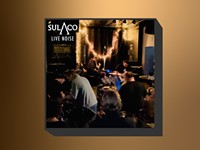
Album Review | 'Live Noise'
Sep 9, 2024 -
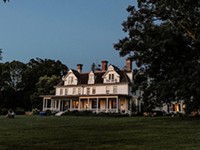
Valley Rising aims to showcase Geneseo as a music destination
Aug 28, 2024 - More »
